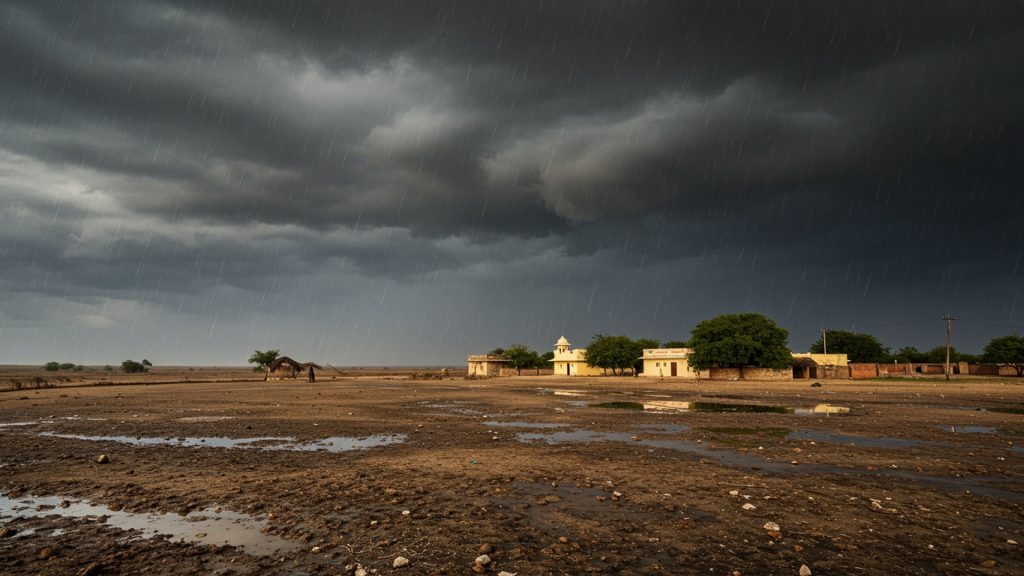A severe monsoon escalation grips Rajasthan, bringing intensified rainfall across the state. Southern districts now brace for exceptionally heavy downpours, a critical situation that prompts concerns for residents and ongoing relief efforts. Weather officials warn of increased water levels and potential disruptions as the strong seasonal rains continue their relentless advance, urging vigilance among communities.
Rainfall Increases Across the State
The monsoon season has become stronger across Rajasthan, bringing widespread rainfall to many parts of the state. This increase in rain follows a period of less intense precipitation. it is now affecting several districts with varying levels of intensity. Weather officials have noted a noticeable shift in weather patterns, with cloud cover and humidity levels rising significantly over the past few days. The air feels heavier. the presence of moisture is evident, which is a clear sign of the monsoon’s active phase.
Many areas that had seen only light showers are now experiencing steady and continuous rainfall. This change is welcomed by farmers who rely on good monsoon rains for their crops, particularly in the agricultural heartlands of Rajasthan. The water levels in local reservoirs and ponds, which are crucial for irrigation and drinking water, have begun to rise. This helps to ease concerns about water availability in the coming months, which is a common issue in this region known for its arid conditions. But, with increased rainfall comes the need for careful management of water, to prevent any issues caused by too much water.
The overall impact on daily life is becoming more apparent. Roads are wet. visibility can be lower during periods of heavy rain. People are taking precautions, such as driving slower and carrying umbrellas. Local markets are also seeing a change, with vendors selling rain-related items becoming more common. The shift from dry weather to a more active monsoon phase is a significant event for Rajasthan, affecting everything from farming to city life.
Southern Districts to Get More Rain
Weather forecasts predict that the southern districts of Rajasthan will receive the heaviest rainfall in the coming days. Areas like Udaipur, Dungarpur, Banswara, Chittorgarh. Pratapgarh are specifically mentioned as places where significant downpours are likely. These districts are naturally more prone to heavy rains due to their geographical location, often receiving the first and strongest impact of the monsoon system moving from the Arabian Sea. The terrain in these southern parts includes hills and valleys, which can sometimes lead to water flowing rapidly and collecting in lower areas.
Residents in these southern areas are advised to be prepared for the possibility of very heavy rain. This means being ready for potential waterlogging in low-lying areas and understanding that streams and rivers might see their water levels rise quickly. Local authorities are already taking steps to inform people about the expected weather. They are using different ways to share data, including public announcements and local news channels, to make sure everyone knows what to expect.
The historical data for these southern districts shows that they often experience more intense monsoon activity compared to the northern or western parts of Rajasthan. This year’s forecast aligns with these historical patterns, suggesting that the current monsoon system is following a typical, strong path. People living near riverbanks or in areas known for collecting water during heavy rain are especially encouraged to stay alert and follow any instructions from emergency services.
Government Taking Steps for Safety
The government and local authorities are actively working to manage the situation and ensure public safety during this period of increased monsoon activity. Meetings have been held with different departments, including disaster management teams, police. health services, to coordinate their efforts. The main goal is to be ready for any challenges that might arise from the heavy rainfall, such as local flooding or disruption to services.
An official statement from the State Disaster Response Force (SDRF) said, “Our teams are on high alert. We have deployed additional personnel and equipment to districts expected to receive heavy rainfall, particularly in the southern region. Control rooms are operating 24/7 to monitor the situation and respond quickly to any emergency calls. We urge citizens to stay calm, avoid unnecessary travel. follow local advisories.”
Resources such as boats, life jackets. rescue equipment are being checked and positioned in vulnerable areas. Emergency helplines have been publicized so that people can easily reach out for help if needed. Plans are also in place for temporary shelters, should any families need to be moved from their homes due to rising water. The focus is on quick action and getting help to people as fast as possible.
Public awareness campaigns are also underway, reminding people about basic safety measures during heavy rains. These include advice on avoiding flooded roads, staying away from electric poles. keeping an eye on children near water bodies. The government aims to work closely with local communities to ensure everyone is prepared and safe.
Impact on Daily Life and Farming
The intensifying monsoon is having a noticeable impact on daily life across Rajasthan. In urban areas, roads are often waterlogged, leading to slower traffic and longer travel times. Public transportation might also experience delays. Schools and colleges in some parts have declared holidays or changed their timings to ensure the safety of students, especially in areas where heavy rain is expected. Businesses might also see fewer customers as people prefer to stay indoors during downpours.
For farmers, the situation is mixed. While the increased rainfall is largely beneficial for kharif crops like maize, millet. pulses, which need good moisture for growth, too much rain can also cause problems. Excessive water can damage standing crops or wash away recently planted seeds. Farmers are closely watching the weather, trying to balance the benefits of rain with the risks of waterlogging. Agricultural experts are advising farmers on best practices to manage their fields during heavy rainfall, such as ensuring proper drainage.
Here is a general overview of crop status in relation to monsoon progress:
| Crop Type | Monsoon Requirement | Current Impact |
|---|---|---|
| Maize | Moderate to High Rain | Mostly Positive. watch for waterlogging in low areas. |
| Millet (Bajra) | Moderate Rain | Beneficial for growth in most areas. |
| Pulses (Moong, Urad) | Moderate Rain | Good for germination and early growth. |
| Groundnut | Consistent Rain | Favorable, critical for pegging stage. |
| Cotton | Steady Rain, not excessive | Generally good. heavy rain can lead to water stagnation. |
The state’s livestock also feels the effects, with farmers needing to ensure their animals are sheltered and have access to clean water. Overall, the intensity of the monsoon brings both relief and challenges. the state is adapting to these changing weather conditions.
What Weather Experts Say
Weather experts and meteorologists are closely monitoring the monsoon’s progress and sharing their insights. They confirm that the current increase in rainfall is part of a typical active monsoon phase. They explain that the low-pressure systems developing over the Bay of Bengal and the Arabian Sea are helping to pull moisture-laden winds deeper into the Indian subcontinent, leading to the current weather patterns over Rajasthan.
A senior meteorologist from the Regional Weather Office stated, “The current spell of heavy rainfall is due to the strengthening of the monsoon trough, which is now positioned favorably over parts of Rajasthan. We anticipate this intensity to continue for the next 48 to 72 hours, particularly affecting the southern and southeastern districts. After this period, we expect a slight reduction in intensity. the monsoon will remain active across the state. Farmers and residents should use this insights to plan their activities.”
They also highlight the importance of timely and accurate forecasts, especially for regions that are prone to sudden heavy rains. The continuous gathering of satellite data and ground-based observations helps them to provide better predictions. The current models show that while the peak intensity might be in the southern districts, other parts of Rajasthan will also continue to receive moderate to heavy showers.
Experts are also looking at the long-term patterns, noting that a strong monsoon is crucial for replenishing groundwater levels, which have been lower in recent years. This year’s rainfall, if sustained, could significantly improve the water situation across the state. They advise people to keep an eye on official weather updates and follow any safety instructions that are issued.

